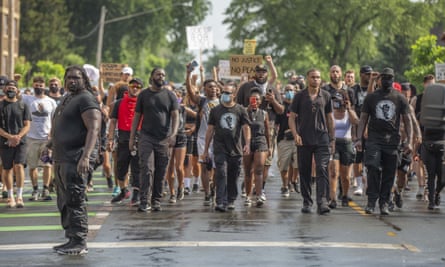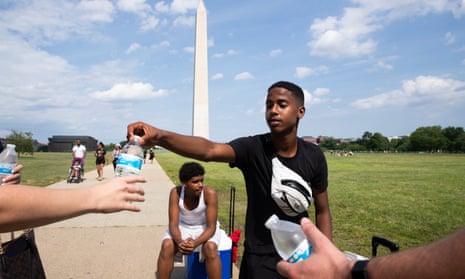Dangerous heatwaves are exacerbating systemic racial inequalities, with soaring temperatures expected to further disadvantage communities of colour if greenhouse gas emissions keep rising, new research shows.
Extreme heat is among the deadliest weather hazards humanity faces due to the climate crisis, which contributes to thousands of deaths in the US every year.
Heatwaves have been occurring more frequently since the mid-20th century, and there’s mounting consensus among climate scientists that dangerous bouts of high temperatures and humidity will become substantially more common, more severe, and longer-lasting without adequate action to curb global heating.
Now, new data provided exclusively to the Guardian by the Union of Concerned Scientists (UCS), reveals:
Killer heat is already affecting communities unequally: between 1971 and 2000, US counties with more than 25% black residents endured an average of 18 days with temperatures above 100F (38C) compared to seven days per year for counties with fewer than 25% African Americans.
By mid-century if Paris climate accord targets are not met, US counties with larger black populations will face a staggering 72 very hot days a year on average – compared with 36 days in counties with smaller African American populations, according to the UCS.
Latin communities also suffer disproportionately: historically, counties with more than a 25% Hispanic/Latinx residents experienced 13 days very hot days a year, rising to 49 by mid-century if greenhouse gas emissions are not curtailed.
“The significantly higher exposure to extreme heat is an artefact of where black people tend to live in the US which is a legacy of slavery,” said senior climate scientist Kristina Dahl, who conducted the county divide analysis for the Guardian.
The findings come as the Guardian launches a series this week, Climate countdown, on the implications of Donald Trump’s decision to take the US out of the Paris climate accord on 4 November, one day after the presidential election.
Dahl added: “Even if rapid action is taken to limit the future temperature rise to 2C, the US can expect a significant increase in the frequency of extreme heat which will affect people of colour most severely as a result of systemic racism. If we blow past that target, the increase and the disparities will be enormous. Extreme heat is a climate justice issue.”
Paris matters
Official figures show that this year is on track to be at least the second hottest on record, though some scientists warn that 2020 could even beat 2016.
Meanwhile coronavirus cases are soaring in much of the country amid sweltering temperatures that make life-saving protective face masks and stay-at-home orders difficult to comply with, and life-saving heat mitigation measures like public cooling centres and swimming pools difficult to provide.
Trump’s decision to withdraw from the Paris agreement triggered widespread international condemnation because failing to reduce greenhouse gasses will have devastating consequences on every aspect of life including our ability to work, study and play.
By mid-century, a third of America’s 481 largest cities will endure temperatures above 105F (40.5C) on at least 30 days a year – a rise from just three cities historically (El Centro and Indio, California, and Yuma, Arizona), according to a landmark UCS report from 2019.

By the end of this century, this would rise to 60% of cities, which is the equivalent of 180 million Americans at risk of potentially fatal complications caused by heatstroke and heat exhaustion. In this scenario, children wouldn’t be able to play outside and farmers would struggle to get crops to market.
Agriculture, an industry which depends on cheap migrant labour, many workers, especially undocumented migrants, already often lack access to crucial mitigation measures such as regular breaks, shade, medical services, adequate clean water and health insurance.
The Covid-19 pandemic is hitting people of color and native communities hardest, and Dahl’s new analysis adds to a growing body of evidence linking systemic racism to the disproportionate impact of the climate crisis, including extreme heat.
Heat islands
In US cities nationwide, heatwaves disproportionately affect underserved neighbourhoods thanks to the legacy of discriminatory housing policies denying home ownership and basic public services to people of colour, according to research published in Climate earlier this year.
This is the result of streets where people of colour lived being graded as “hazardous” starting in the 1930s – otherwise known as redlining – which were then denied a whole range of public and private services including banking, healthcare and parks, while being earmarked for environmentally toxic projects such as landfills and chemical plants.
Urban heat islands – characterised by abundant heat-trapping structures such as housing projects and asphalt car parks, and inadequate vegetation – are up to 12.6F hotter than non-redlined neighborhoods in the same city.
The heat disparity exists in 94% of the 108 cities analysed. For instance in Birmingham, Alabama, the average temperature in redlined neighbourhoods, which account for 64% of the city, is currently 8F higher than historically white neighbourhoods.
Vivek Shandas, professor of urban studies and planning at Portland State University and lead author of the Climate study, said: “It was a systematic insidious process which has had a domino effect on underserved communities that today we see playing out in terms of climate impact.”
Heatwaves will continue to be worse in the south, but extreme temperatures are also expanding to areas unaccustomed and ill equipped to mitigate the impact, according to Jen Brady, senior data analyst at Climate Central, a not-for-profit group.
It's not an illusion: Summers are getting hotter across much of the U.S. Check your location here: https://t.co/5OE8Qwzf6L #ClimateMatters pic.twitter.com/OQrXzMieI5
— Climate Central (@ClimateCentral) July 21, 2020
In Minneapolis, where the police killing of George Floyd triggered nationwide anti-racism protests, the average daytime summer temperature has risen 2.3F since the 1970s; at night it’s up by 4.3F, according to Climate Central. The number of above-average hot days is up by 25% over the same period.
As with police brutality, racism also dictates exposure to deadly heat. In Minneapolis, former redlined neighbourhoods, where mostly low-income people and people of colour still live, are almost 11F hotter – the third-largest temperature disparity after Denver and Portland.

It’s not just the lack of trees and parks, access to economic resources to mitigate the harmful, potentially fatal impact of extreme heat such as air conditioning, cinema tickets, and even bus fare to reach a mall, is also inequitable, studies show.
In 2016, the net worth of a typical white family was $171,000 – almost 10 times greater than that of a black family, according to the Brookings Institution.
Meanwhile, underlying health and environmental hazards which more commonly affect people of colour such as air pollution, diabetes, obesity and high blood pressure, also increase the risk of heat-related illnesses.
School performance
On very hot days, students struggle to learn as a result of heat-induced physiological changes. As the temperature climbs, children in schools without adequate air conditioning perform worse in tests.
In one recent nationwide study, using data from over 12,000 schools and 10 million middle- and high-school students, researchers found that a 1F hotter-than-average academic year reduces learning by about 1%.
But the effects of heat on learning are more pronounced for black and brown students and those living in poorer neighborhoods, because air conditioning – like other essential school infrastructure – is locally funded and unequally distributed.
The negative impact of heat accumulates, according to the data published in the American Economic Journal, which suggests that up to 7% of racial achievement gaps can be attributed to a combination of more hot days and hotter classrooms for African American and Latin students.
In an op-ed for USA Today last year, co-author R Jisung Park, an environmental economist at UCLA’s Luskin Center for Innovation, wrote: “Washington contributes essentially $0 to improving or maintaining school facilities. This is shortsighted … adapting to climate change is a matter of racial and economic justice, especially in schools.”
